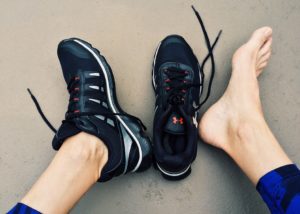Dealing with Blisters

Blisters. Just the name itself send shivers through my body! Many people can walk for miles without suffering but for others like me, they can be really painful.
Interestingly enough, long distance walking is a great leveler. Even those people who wouldn’t normally get blisters from shorter walks will often get blisters when walking longer distances like on the Camino. This is because you will be exposed to a combination of hot, cold, friction and rubbing.
Different Techniques of dealing with blisters
I have researched many different techniques people use to firstly try and prevent blisters, and then to deal with them should they occur. And believe me I have tried many techniques. In the end it all comes down to the technique that works for you and I’m now philosophical about blisters. I know I will always be prone to them so it’s just a matter of dealing with them.
Blister prevention
Here are some of the techniques I have come across to try and prevent blisters:
- strapping your feet
- using lambs wool which you wrap in and around each toe
- using second skin plasters
- hardening your feet with surgical meths
- softening your feet
- lubricating your feet with products such as Body Glide
- using antiperspirant on your feet
- rubbing talc powder into your feet
- removing hard skin
- wearing various types of socks
- finding shoes that are wide enough for your feet
- wearing shoes that aren’t too tight or too loose
- wearing two layers of socks
- wearing pressure point padding
- not walking!
I would recommend trying out different types of socks, both woolen and synthetic, to find the ones that suit you the best. Things to look out for are whether they are padded, soft, have any seams which will rub and how they absorb moisture.
Likewise with shoes. There are many makes and models out there and it’s important to find a pair that are wide enough for your feet so that you can move your toes comfortably. At the same time you don’t want them to be too tight or too loose. Also look out of rough edges on insoles however this can be taken care of by wearing padded insoles with soft edges.
How to treat your Blisters
So what do you do when you get blisters? Once again there are many different schools of thought on this one. The two most effective ways I have found are to use needling, or piercing them with a pair of sharp sterilised scissors to release the pressure and liquid, before cleaning them and covering them.
By needling I literally mean using a needle and thread to pierce the skin and then pulling the thread through the blister. You then cut the thread off so it’s not too long and the liquid will run out down the thread. You leave the thread in there for a while until all the liquid has drained away and cover it with a plaster. And if you are dealing with big meaty blisters this can take a while.
For smaller blisters I just nick the skin with a pair of sharp scissors to release the fluid, apply pressure and then clean and cover.
If you get rid of all the fluid you will usually find most blisters are ok by your next day of walking but in some cases you may find you need to apply constant first aid to them.
I have seen some pretty nasty blisters in my time, both on myself and on others and part of the ritual of doing any long walk is the daily treatment that needs to take place at the end of the walking day.
Don’t do what I did!
On my first Camino I had a really bad experience with some blisters on the outside of both my feet and unfortunately I made some bad decisions when dealing with them.
I started to develop some blisters so used ‘Compeed’ plasters on them. Bad move. They act as a second skin and are meant to stop any friction as they have a shiny surface. You should only ever use a product like this when you feel a hot spot coming on, not when you have actually developed a blister.
I made the mistake of applying them to blisters that had already formed. So what happened was that the edges of the plasters started coming off when I was walking and got caught up with the rather large blisters beneath. When I went to remove the plasters at the end of my day I also removed several layers of skin. This resulted in me getting infected blisters which meant trying to find a medical centre in the middle of Spain to get antibiotics. It was not a pleasant experience and meant that these particular blisters took weeks to heal.
I know some people swear by second skin products like Compeed. I’m not saying they don’t work. Just don’t put them on a blister that has already developed.
In the end it comes down with trying out lots of different techniques to find the one that works best for you. But just remember, you’re not alone when it comes to blisters.
But also remember, that once your walking day is over, you can take your shoes off and relax (preferably with a glass of wine)!

